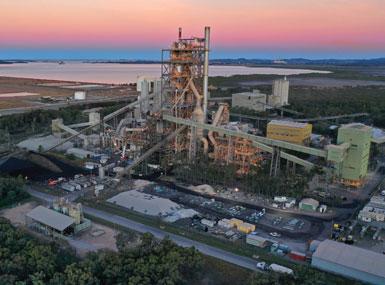Cement Australia may be in the business of binding, but when comes to progress, it is determined to prove it is a construction services supplier that is anything but stuck.
By Tracey Porter
There are few Australian businesses whose company history can be traced back nearly 150 years. There are fewer still who have structured their operations to all but guarantee they will still be around for another century and a half.
Cement Australia is one such anomaly.
Formed from a merger of Queensland Cement and Australian Cement Holdings—as well as an assortment of other acquisitions which have taken place along the way—the business boasts a rich history dating back to 1890.
From its humble beginnings using vertical kilns and horse-drawn carts, the company today has several milling and storage terminals as well as two fully integrated cement manufacturing facilities.
Employing hundreds of people in regional communities across Australia, it manufactures at plants everywhere from Gladstone in central Queensland to Railton in northern Tasmania. It is from these sites that Cement Australia produces the majority of its product, the line-up of which includes general-purpose cement and general blended cement including customised blends for special applications.
In addition, it also supplies concrete grade fly-ash and ground granulated blast furnace slag.
Cement Australia’s packaged products & marketing manager Marc Furlong has been in his current role for six months but has worked for Cement Australia for nearly two decades. Furlong says while cement is an ingredient in concrete, most people mistakenly believe they are the same thing.
As well as producing cement products for the building, construction, civil infrastructure and mining sectors, the company—a fifty-fifty joint venture owned by Holcim and Heidelberg Materials—also produces quicklime for the manufacturing, mining and agricultural sectors.
Furlong believes the business has been so well supported among its core clientele of market-leading building and engineering contractors, retail building suppliers and large Australian mines, because while Cement Australia’s production processes have changed over the years, the fundamentals of the business haven’t.
“At our core, we are a cement manufacturer. However, the cement manufacturing process has changed over the years and become much more efficient; the types of kilns and mills used today are almost unrecognisable from those used in the 1800s. The widespread use of pozzolanic materials such as fly-ash in the 1990s was another significant change in the industry and over the years these types of supplementary materials have become increasingly more important.”
Taking very seriously today’s corporate imperative to operate sustainably, Cement Australia has made a concerted effort in recent years to focus on eco-efficient production and on controlling the impacts of its activities on the environment.
Furlong says as the world’s most widely used construction material, concrete has a significant carbon footprint.
As the necessary binding ingredient for concrete, cement manufacturing is associated with inevitable CO2 emissions, due to the physical and chemical processes.
To get around this, while also doing its bit to contribute towards the cement and concrete industry’s ambition for net zero carbon concrete by 2050, Cement Australia has implemented an environmental management system that is externally certified.
Furlong says through its alternative fuels and raw materials management strategies, it has committed to replacing first-use materials, wherever practical.
In addition, it manages specific waste streams from the power generation and steel industries, taking these materials and turning them into supplementary cementitious materials for use in a broad range of applications such as producing high-performance and/or low-carbon concrete.
“We understand the need to ensure and maintain a safe, healthy and productive workplace for our people and a social license to operate—this is at the core of our sustainability strategy,” he says.
Another string to Cement Australia’s bow when it comes to its green credentials is the introduction of its Geocycle arm, which launched in 1999. This offshoot of the business provides waste management services to the generators and consolidators of waste and transforms that material into alternative fuels and raw materials that are used in the cement kilns. In 2001 alone, the company blended and converted more than 21,000kL of industrial waste that would have otherwise gone to landfill. In the same year, it produced 26,400kL of alternative fuel replacement, replacing at least 28,800 tonnes of coal and saving around 14,400 tonnes of CO2 from going into the atmosphere.
More recently Cement Australia has introduced a new line it calls GreenCem, which Furlong says is a suite of products that have been in development for several years.
Essentially a range of non-toxic additives that can be used in cement-based products to reduce Portland cement content, the range has been engineered by Cement Australia to enable very high levels (up to 80 per cent) of cement replacement with fly-ash and/or slag “without significantly compromising concrete performance”, he says.
Furlong believes both GreenCem and Geocycle will play a significant role in ensuring Cement Australia continues to produce sustainable, high-quality products now and in the future.
“We are looking at ways we can improve the sustainability of packaging. Some in our industry have in recent years moved to plastic packaging. We made a very conscious decision to retain paper sacks and in the coming years, we will continue to reduce non-degradable and non-recyclable packaging.
“We have recently announced a couple of initiatives that have the potential to dramatically reduce greenhouse gas emissions at our Gladstone plant. We recently added our first fully electric truck to our fleet, the first of its type in Australia. In coming years that capability is likely to expand.
Continuing to improve our sustainability is a key focus in both the short and long term.”






